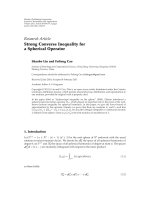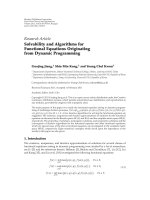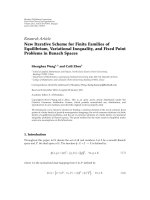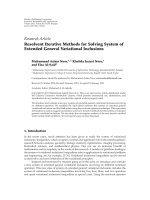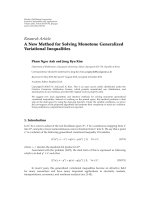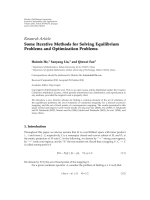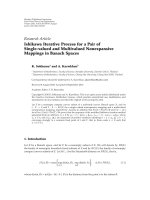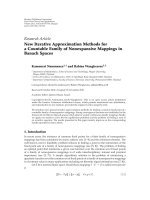Báo cáo hóa học: " Research Article Resolvent Iterative Methods for Solving System of Extended General Variational Inclusions" potx
Bạn đang xem bản rút gọn của tài liệu. Xem và tải ngay bản đầy đủ của tài liệu tại đây (500.53 KB, 10 trang )
Hindawi Publishing Corporation
Journal of Inequalities and Applications
Volume 2011, Article ID 371241, 10 pages
doi:10.1155/2011/371241
Research Article
Resolvent Iterative Methods for Solving System of
Extended General Variational Inclusions
Muhammad Aslam Noor,
1, 2
Khalida Inayat Noor,
1
and Eisa Al-Said
2
1
Mathematics Department, COMSATS Institute of Information Technology, Islamabad 44000, Pakistan
2
Mathematics Department, College of Science, King Saud University, Riyadh 11451, Saudi Arabia
Correspondence should be addressed to Muhammad Aslam Noor,
Received 1 October 2010; Revised 4 January 2011; Accepted 10 January 2011
Academic Editor: Mohamed A. El-Gebeily
Copyright q 2011 Muhammad Aslam Noor et al. This is an open access article distributed under
the Creative Commons Attribution License, which permits unrestricted use, distribution, and
reproduction in any medium, provided the original work is properly cited.
We introduce and consider some new systems of extended general variational inclusions involving
six different operators. We establish the equivalence between this system of extended general
variational inclusions and the fixed points using the resolvent operators technique. This equivalent
formulation is used to suggest and analyze some new iterative methods for this system of extended
general variational inclusions. We also study the convergence analysis of the new iterative method
under certain mild conditions. Several special cases are also discussed.
1. Introduction
In the recent years, much attention has been given to study the system of variational
inclusions/inequalities, which occupies a central and significant role in the interdisciplinary
research between analysis, geometry, biology, elasticity, optimization, imaging processing,
biomedical sciences, and mathematical physics. One can see an immense breadth of
mathematics and its simplicity in the works of this research. A number of problems leading to
the system of variational inclusions/inequalities arise in applications to variational problems
and engineering, see; for example, 1–31. Variational inclusions/inequalities can be viewed
as innovative and novel extension of the variational principles.
Inspired and motivated by research going on in this area, we introduce and consider
a new system of extended general variational inclusions involving six different nonlinear
operators. This new class of system of extended general variational inclusions includes the
system of variational inclusions/inequalities involving five, four, three, and two operators
and quasi variational inclusions/inequalities as special cases. Using the resolvent operator
2 Journal of Inequalities and Applications
technique, we establish the equivalence between the new system of general variational
inclusions and the fixed point problem. This alternative equivalent formulation is used to
suggest and analyze some iterative methods for solving this system of extended general
variational inclusions. Several special cases of these iterative algorithms are also discussed.
We also prove the convergence of the proposed iterative methods under weaker conditions.
Since the new system of extended general variational inclusions/inequalities includes the
system of variational inclusions/inequalities and related optimization problems as special
cases, results proved in this paper continue to hold for these problems. Our result can
be viewed as refinement and improvement of the previous results in this field. The
interested readers are advised to explore this field further and discover some new and
novel applications of these system of extended general variational inclusions/inequalities in
various branches of pure and applied sciences. This field of study is not much developed and
offers several opportunities for future research. For example, see 5, 6 and the references
therein, for the applications of recurrent neural network regarding the extended general
variational inequalities.
2. Preliminaries
Let H be a real Hilbert space whose inner product and norm are denoted by ·, · and ·,
respectively, Let K be a closed and convex set in H.LetT
1
,T
2
,A,g,h,g
1
: H → H be
nonlinear different operators, and let ϕ : H → R ∪{∞} be a continuous function.
We now consider the problem of finding x
∗
,y
∗
∈ H such that
0 ∈ ρT
1
y
∗
ρA
g
1
x
∗
− g
y
∗
g
1
x
∗
,ρ>0,
0 ∈ ηT
2
x
∗
ηA
h
1
y
∗
g
1
y
∗
− h
x
∗
,η>0,
2.1
which is called the system of general variational inclusions involving seven different
operators.
We now discuss some special cases of the system of general variational inclusions
2.1.
i If T
1
T
2
T and g h g
1
,ρ η, x x
∗
y
∗
, then 2.1 is equivalent to finding
x ∈ H, such that
0 ∈ ρT
x
ρA
g
x
, 2.2
which is known as the variational inclusion problem or finding the zero of the sum
of two more monotone operators 8–12. It is well known that a wide class of
linear and nonlinear problems can be studied via variational inclusion problems.
ii We note that, if A·∂ϕ·,thesubdifferential of a proper, convex, and lower-
semicontinuous function, then 2.1 is equivalent to finding x
∗
,y
∗
∈ H, such that
ρT
1
y
∗
g
1
x
∗
− g
y
∗
,g
x
− g
1
x
∗
≥ ρϕ
g
1
x
∗
− ρϕ
g
x
, ∀x ∈ H, ρ > 0,
ηT
2
x
∗
h
1
y
∗
− h
x
∗
,h
x
− g
1
y
∗
≥ ηϕ
g
1
y
∗
− ηϕ
h
x
, ∀x ∈ H, η > 0,
2.3
Journal of Inequalities and Applications 3
which is called the system of mixed general variational inequalities involving five
different nonlinear operators and appears to be a new one.
iii If T
1
T
2
T, then 2.3 reduces to the following system of mixed general
variational inequalities of finding x
∗
,y
∗
∈ H, such that
ρT
y
∗
g
1
x
∗
− g
y
∗
,g
x
− g
1
x
∗
≥ρϕ
g
1
x
∗
− ρϕ
g
x
, ∀x ∈ H, ρ > 0,
ηT
x
∗
h
1
y
∗
− h
x
∗
,h
x
− g
1
y
∗
≥ηϕ
g
1
y
∗
− ηϕ
h
x
, ∀x ∈ H, η > 0.
2.4
iv If ϕ is an indicator function of a closed and convex set K in H, then 2.4 is
equivalent to finding x
∗
,y
∗
∈ K, such that
ρT
y
∗
g
1
x
∗
− g
y
∗
,g
x
− g
1
x
∗
≥ 0, ∀x ∈ H : g
x
∈ K, ρ > 0,
ηT
x
∗
g
1
y
∗
− h
x
∗
,h
x
− g
1
y
∗
≥ 0, ∀x ∈ H : h
x
∈ K, η > 0,
2.5
is called the system of extended general variational inequalities involving five
different operators, which has been studied by Noor 23.
v If T
1
T
2
T,h g
1
, then 2.5 is equivalent to finding x
∗
∈ K such that
Tx
∗
,g
x
− h
x
∗
≥ 0, ∀x ∈ H : g
x
∈ K, 2.6
which is known as the extended general variational inequality introduced and
studied by Noor 16 in 2009. It has been shown 16 that the minimum of a
differentiable nonconvex function on the nonconvex set can be characterized by
the extended general variational inequality 2.6. For the neural network technique
for solving 2.6,see5, 6. In particular, for suitable and appropriate choice of
the operators, one can obtain the various classes of variational inclusions and
variational inequalities. This shows that the system of extended general variational
inclusions involving seven different operators 2.1 is more general and includes
several classes of variational inclusions/inequalities and related optimization
problems as special cases. For the recent applications, numerical methods, and
formulations of variational inequalities and variational inclusions, see 1–31 and
the references therein.
3. Iterative Algorithms
In this section, we suggest some explicit iterative algorithms for solving the system of general
variational inclusion 2.1. First of all, we establish the equivalence between the system of
variational inclusions and fixed point problems. For this purpose, we recall the following
well-known result.
4 Journal of Inequalities and Applications
Definition 3.1 see 1. For any maximal operator T, the resolvent operator associated with
T, for any ρ>0, is defined as
J
T
u
I ρT
−1
u
, ∀u ∈ H. 3.1
It is well known that an operator T is maximal monotone if and only if its resolvent operator
J
T
is defined everywhere. It is single valued and nonexpansive, that is,
J
A
u − J
A
v
≤
u − v
, ∀u, v ∈ H. 3.2
We now show that the system of extended general variational inclusions 2.1 is
equivalent to the fixed point problem and this is the motivation of our next result.
Lemma 3.2. If the operator A is maximal monotone, then x
∗
,y
∗
∈ H is a solution of 2.1,ifand
only if, x
∗
,y
∗
∈ H satisfies
g
1
x
∗
J
A
g
y
∗
− ρT
1
y
∗
,
g
1
y
∗
J
A
h
x
∗
− ηT
2
x
∗
.
3.3
Proof. Let x
∗
,y
∗
∈ H be a solution of 2.1. Then
g
y
∗
− ρT
1
y
∗
∈
I ρA
g
1
x
∗
,
h
x
∗
− ηT
2
x
∗
∈
I ηA
g
1
y
∗
,
3.4
which implies that
g
1
x
∗
J
A
g
y
∗
− ρT
1
y
∗
,
g
1
y
∗
J
A
h
x
∗
− ηT
2
x
∗
,
3.5
the required result.
This equivalent formulation is used to suggest and analyze an iterative method for
solving 2.1. To do so, one rewrite 3.3 in the following form:
x
∗
1 − a
n
x
∗
a
n
x
∗
− g
1
x
∗
a
n
J
A
g
y
∗
− ρT
1
y
∗
, 3.6
y
∗
y
∗
− g
1
y
∗
J
A
h
x
∗
− ηT
2
x
∗
, 3.7
where a
n
∈ 0, 1 for all n ≥ 0 satisfies some suitable conditions.
This alternative equivalence formulation enables us to suggest the following explicit
iterative method for solving 2.1.
Journal of Inequalities and Applications 5
Algorithm 1. For arbitrarily chosen initial points x
0
,y
0
∈ K compute the sequence {x
n
} and
{y
n
} by
x
n1
1 − a
n
x
n
a
n
x
n1
− g
1
x
n1
a
n
J
A
g
y
n
− ρT
1
y
n
,
y
n1
y
n1
− g
1
y
n1
J
A
h
x
n1
− ηT
2
x
n1
,
3.8
where a
n
∈ 0, 1 for all n ≥ 0 satisfies some suitable conditions.
For g
1
g and g
1
h, Algorithm 1 reduces to the following algorithm for solving
2.1.
Algorithm 2. For arbitrarily chosen initial points x
0
,y
0
∈ K compute the sequence {x
n
} and
{y
n
} by
x
n1
1 − a
n
x
n
a
n
x
n1
− g
x
n1
a
n
J
A
g
y
n
− ρT
1
y
n
, 3.9
y
n1
y
n1
− h
y
n1
J
A
h
x
n1
− ηT
2
x
n1
, 3.10
where a
n
∈ 0, 1 for all n ≥ 0 satisfies some suitable conditions.
For suitable and appropriate choice of the operators T
1
,T
2
,A,g,h,g
1
and spaces, one
can obtain a wide class of iterative methods for solving different classes of variational
inclusions and related optimization problems. This shows that Algorithm 1 is quite flexible
and general and includes various known and new algorithms for solving variational
inequalities and related optimization problems as special cases.
Definition 3.3. A mapping T : H → H is called r-strongly monotone, if and only if, there
exists a constant r>0, such that
Tx − Ty,x − y
≥ rx − y
2
, ∀x, y ∈ H. 3.11
Definition 3.4. A mapping T : H → H is called relaxed γ-cocoercive, if and only if, there
exists a constant γ>0, such that
Tx − Ty,x − y
≥−γTx− Ty
2
, ∀x, y ∈ H. 3.12
Definition 3.5. A mapping T : H → H is called relaxed γ,r-cocoercive, if and only if, there
exists constants γ>0,r >0, such that
Tx − Ty,x − y
≥−γTx− Ty
2
rx − y
2
, ∀x, y ∈ H. 3.13
The class of relaxed γ,r-cocoercive mappings is more general than the class of
strongly monotone mappings. It is known that the relaxed γ,r-cocoercivity implies strongly
monotonicity, but the converse is not true.
6 Journal of Inequalities and Applications
Definition 3.6. A mapping T : H → H is called μ-Lipschitzian, if and only if, there exists a
constant μ>0, such that
Tx − Ty
≤ μ
x − y
, ∀x, y ∈ H. 3.14
4. Main Results
In this section, we consider the convergence criteria of Algorithm 2 under some suitable mild
conditions and this is the main motivation of this paper. In a similar way, one can consider
the convergence analysis of Algorithm 1.
Theorem 4.1. Let x
∗
, y
∗
be a solution of 2.1.IfT
1
: H → H is relaxed γ
1
,r
1
-cocoercive and
μ
1
-Lipschitzian and T
2
: H × H → H is relaxed γ
2
,r
2
-cocoercive and μ
3
-Lipschitzian, Let g be
a relaxed γ
3
,r
3
-cocoercive and μ
3
-Lipschitzian. Let the operator h be relaxed γ
4
,r
4
-cocoercive and
μ
4
-Lipschitzian. If the operator g
1
is relaxed γ
5
,r
5
-cocoercive and μ
5
-Lipschitzian, then
ρ −
r
1
− γ
1
μ
2
1
μ
2
1
<
r
1
− γ
1
μ
2
1
2
− μ
2
1
μ
2 − μ
μ
2
1
,r
1
>γ
1
μ
2
1
μ
1
μ
2 − μ
,μ k k
3
< 1,
4.1
η −
r
2
− γ
2
μ
2
2
μ
2
2
<
r
2
− γ
2
μ
2
2
2
− μ
2
2
ν
2 − ν
μ
2
2
,r
2
>γ
2
μ
2
2
μ
2
ν
2 − ν
,ν k
1
k
3
< 1,
4.2
where
k
1 − 2
r
3
− γ
3
μ
2
3
μ
2
3
,k
1
1 − 2
r
4
− γ
4
μ
2
4
μ
2
4
,k
3
1 − 2
r
5
− γ
5
μ
2
5
μ
2
5
,
4.3
and a
n
∈ 0, 1,
∞
n0
a
n
∞, then for arbitrarily chosen initial points x
0
,y
0
∈ H, x
n
and y
n
obtained from Algorithm 1 converge strongly to x
∗
and y
∗
, respectively.
Proof. From 3.6, 3.9, and the nonexpansive property of the resolvent operator J
A
, we h ave
x
n1
− x
∗
x
n1
− g
1
x
n1
J
ϕ
g
y
n
− ρT
1
y
n
−
x
∗
− g
1
x
∗
− J
ϕ
g
y
∗
− ρT
1
y
∗
≤
x
n1
− x
∗
−
g
1
x
n1
− g
1
x
∗
J
ϕ
g
y
n
− ρT
1
y
n
− J
ϕ
g
y
∗
− ρT
1
y
∗
≤
x
n1
− x
∗
−
g
1
x
n1
− g
1
x
∗
g
y
n
− ρT
1
y
n
−
g
y
∗
− ρT
1
y
∗
x
n1
− x
∗
−
g
1
x
n1
− g
1
x
∗
y
n
− y
∗
− ρ
T
1
y
n
− T
1
y
∗
y
n
− y
∗
−
g
y
n
− g
y
∗
.
4.4
Journal of Inequalities and Applications 7
From the relaxed γ
1
,r
1
-cocoercive and μ
1
-Lipschitzian of T
1
, we have
y
n
− y
∗
− ρ
T
1
y
n
− T
1
y
∗
2
y
n
− y
∗
2
− 2ρ
T
1
y
n
− T
1
y
∗
,y
n
− y
∗
ρ
2
T
1
y
n
− T
1
y
∗
2
≤
y
n
− y
∗
2
− 2ρ
−γ
1
T
1
y
n
− T
1
y
∗
2
r
1
y
n
− y
∗
2
ρ
2
T
1
y
n
− T
1
y
∗
2
≤
y
n
− y
∗
2
2ργ
1
μ
2
1
y
n
− y
∗
2
− 2ρr
1
y
n
− y
∗
2
ρ
2
μ
2
1
y
n
− y
∗
2
1 2ργ
1
μ
2
1
− 2ρr
1
ρ
2
μ
2
1
y
n
− y
∗
2
.
4.5
In a similar way, using the γ
3
,r
3
-cocoercivity and μ
3
-Lipschitz continuity of the operator g
and γ
5
,r
5
-cocoercivity and μ
5
-Lipschitz continuity of the operator g
1
, we have
y
n
− y
∗
−
g
y
n
− g
y
∗
≤ k
y
n
− y
∗
, 4.6
y
n
− y
∗
−
g
1
y
n
− g
1
y
∗
≤ k
3
y
n
− y
∗
, 4.7
where k and k
3
are defined by 4.3.Set
θ
1
k
1 2ργ
1
μ
2
1
− 2ρr
1
ρ
2
μ
2
1
1/2
1 − k
3
. 4.8
It is clear from condition 4.1 that 0 ≤ θ
1
< 1. Hence from 4.5,4.6,and4.7, it follows that
x
n1
− x
∗
≤ θ
1
y
n
− y
∗
. 4.9
Similarly, from the relaxed γ
2
,r
2
-cocoercive and μ
2
-Lipschitzian of T
2
,weobtain
x
n1
− x
∗
− η
T
2
x
n1
− T
2
x
∗
2
x
n1
− x
∗
2
− 2η
T
2
x
n1
− T
2
x
∗
,x
n1
− x
∗
η
2
T
2
x
n1
− T
2
x
∗
2
≤
x
n1
− x
∗
2
− 2η
−γ
2
T
2
x
n1
− T
2
x
∗
2
r
2
x
n1
− x
∗
2
η
2
T
2
x
n1
− T
2
x
∗
2
x
n1
− x
∗
2
2ηγ
2
T
2
x
n1
− T
2
x
∗
2
− 2ηr
2
x
n1
− x
∗
2
η
2
T
2
x
n1
− T
2
x
∗
2
≤
x
n1
− x
∗
2
2ηγ
2
μ
2
2
x
n1
− x
∗
2
− 2ηr
2
x
n1
− x
∗
2
η
2
μ
2
2
x
n1
− x
∗
2
1 2ηγ
2
μ
2
2
− 2ηr
2
η
2
μ
2
2
x
n1
− x
∗
2
.
4.10
8 Journal of Inequalities and Applications
Also, using the γ
4
,r
4
-cocoercivity and μ
4
-Lipschitz continuity of the operator h, we have
y
n
− y
∗
−
h
y
n
− h
y
∗
≤ k
1
y
n
− y
∗
, 4.11
where k
1
is defined by 4.3.
Hence from 3.7, 3.10, 4.7, 3.7,and4.11, we have
y
n1
− y
∗
y
n1
− y
∗
−
g
1
y
n1
− g
1
y
∗
J
ϕ
h
x
n1
− ηT
2
x
n1
− J
ϕ
h
x
∗
− ηT
2
x
∗
≤
y
n1
− y
∗
−
g
1
y
n1
− g
1
y
∗
x
n1
− x
∗
− η
T
2
x
n1
−T
2
x
n
x
n1
− x
∗
−
h
x
n1
− h
x
∗
,
4.12
which implies that
y
n1
− y
∗
≤ θ
2
x
n1
− x
∗
, 4.13
where
θ
2
k
1
1 2ργ
1
μ
2
1
− 2ρr
1
ρ
2
μ
2
1
1/2
1 − k
3
. 4.14
From 4.2, it follows that θ
2
< 1.
From 4.9 and 4.13,weobtainthat
x
n1
− x
∗
≤ θ
1
θ
2
x
n
− x
∗
. 4.15
Since θ
1
θ
2
< 1, it follows that lim
n →∞
{x
n
− x
∗
} 0. Hence the result lim
n →∞
{y
n
− y
∗
} 0
is from 4.11. This completes the proof.
Remarks 4.2. It is well known 5, 6 that the traditional algorithms may not be efficient due
to the structure of the problems. To overcome this drawback, one usually uses the artificial
neural network based on the circuit implementation. It has been shown 5, 6 that the neural
network models are efficient in solving variational inequalities and related optimization
problems. The recurrent neural network methods have applications in kinematics control,
support vector machine learning, and related branches of engineering. Using the technique
and ideas of Liu and Cao 5 and Liu and Yang 6, one can consider the recurrent
neural network based on the resolvent operator f or solving the system of extended general
variational inclusions 2.1 and its special cases. This is an interesting problem for future
research. Such type of systems of extended general variational inclusions may have important
and significant applications in engineering and applied sciences. For more general systems of
general variational inequalities/inclusions, see the work of Noor and Noor 27, 28 and the
references therein.
Journal of Inequalities and Applications 9
5. Conclusion
In this paper, we have introduced and considered a new system of extended general
variational inclusions involving six different operators. We have established the equivalent
between the system of variational inclusions and the fixed point problem using the resolvent
operator. This equivalence i s used to suggest and analyze some iterative methods for solving
the extended general system of variational inclusion. Several special cases are also discussed.
Acknowledgments
This research is supported by the Visiting Professor Program of King Saud University,
Riyadh, Saudi Arabia and Research Grant no. VPP.KSU.108. The authors would like to
express their gratitude to the referee for his/her constructive and valuable comments.
References
1 H. Brezis, Operateurs Maximaux Monotone et Semigroupes de Contractions dans les Espace d’Hilbert, North-
Holland, Amsterdam, Holland, 1973.
2 S. S. Chang, H. W. J. Lee, and C. K. Chan, “Generalized system for relaxed cocoercive variational
inequalities in Hilbert spaces,” Applied Mathematics Letters, vol. 20, no. 3, pp. 329–334, 2007.
3 R. Glowinski, J L. Lions, and R. Tr
´
emoli
`
eres, Numerical Analysis of Variational Inequalities, vol. 8 of
Studies in Mathematics and Its Applications, North-Holland, Amsterdam, The Netherlands, 1981.
4 Z. Huang and M. A. Noor, “An explicit projection method for a system of nonlinear variational
inequalities with different γ,r-cocoercive mappings,” Applied Mathematics and Computation, vol. 190,
no. 1, pp. 356–361, 2007.
5 Q. Liu and J. Cao, “A recurrent neural network based on projection operator for extended general
variational inequalities,” IEEE Transactions on Systems, Man, and Cybernetics, Part B,vol.40,no.3,pp.
928–938, 2010.
6 Q. Liu and Y. Yang, “Global exponential system of projection neural networks for system of
generalized variational inequalities and related n onlinear minimax problems,” Neurocomputing,vol.
73, no. 10-12, pp. 2069–2076, 2010.
7 M. A. Noor, “General variational inequalities,” Applied Mathematics Letters, vol. 1, no. 2, pp. 119–122,
1988.
8 M. A. Noor, “Some algorithms for general monotone mixed variational inequalities,” Mathematical
and Computer Modelling, vol. 29, no. 7, pp. 1–9, 1999.
9 M. A. Noor, “New approximation schemes for general variational inequalities,” Journal of
Mathematical Analysis and Applications, vol. 251, no. 1, pp. 217–229, 2000.
10 M. A. Noor, “New extragradient-type methods for general variational inequalities,” Journal of
Mathematical Analysis and Applications, vol. 277, no. 2, pp. 379–394, 2003.
11 M. A. Noor, “Some developments in general variational inequalities,” Applied Mathematics and
Computation, vol. 152, no. 1, pp. 199–277, 2004.
12 M. A. Noor, “Differentiable non-convex functions and general variational inequalities,” Applied
Mathematics and Computation, vol. 199, no. 2, pp. 623–630, 2008.
13 M. A. Noor, “Projection methods for nonconvex variational inequalities,” Optimization Letters, vol. 3,
no. 3, pp. 411–418, 2009.
14 M. A. Noor, Prinicples of Variational Inequalities, Lap-Lambert Academic, Saarbruchen, Germany, 2009.
15 M. A. Noor, “Some iterative methods for nonconvex variational inequalities,” Computational
Mathematics and Modeling, vol. 21, no. 1, pp. 97–108, 2010.
16 M. A. Noor, “Extended general variational inequalities,” Applied Mathematics Letters, vol. 22, no. 2, pp.
182–186, 2009.
17 M. A. Noor, “Sensitivity analysis of extended general variational inequalities,” Applied Mathematics
E-Notes, vol. 9, pp. 17–26, 2009.
18 M. A. Noor, “Some iterative algorithms for extended general variational inequalities,” Albanian
Journal of Mathematics, vol. 2, no. 4, pp. 265–275, 2008.
10 Journal of Inequalities and Applications
19 M. A. Noor, “Projection iterative methods for extended general variational inequalities,” Journal of
Applied Mathematics and Computing, vol. 32, no. 1, pp. 83–95, 2010.
20 M. A. Noor, “On a system of general mixed variational inequalities,” Optimization Letters, vol. 3, no.
3, pp. 437–451, 2009.
21 M. A. Noor, “Iterative methods for solving systems of general nonconvex variational inequalities,”
International Journal of Mathematics and Mathematical Sciences, vol. 1, pp. 56–65, 2010.
22 M. A. Noor, “Auxiliary principle technique for extended general variational inequalities,” Banach
Journal of Mathematical Analysis, vol. 2, no. 1, pp. 33–39, 2008.
23 M. A. Noor, “Some new systems of general nonconvex variational inequalities involving five different
operators,” Nonlinear Analysis Forum, vol. 15, pp. 171–179, 2010.
24 M. A. Noor, “On iterative methods for solving a system of mixed variational inequalities,” Applicable
Analysis, vol. 87, no. 1, pp. 99–108, 2008.
25 M. A. Noor, “On a system of general mixed variational inequalities,” Optimization Letters, vol. 3, no.
3, pp. 437–451, 2009.
26 M. A. Noor, “Resolvent methods for solving a system of variational inclusions,” International Journal
of Modern Physics B. In press.
27 M. A. Noor and K. I. Noor, “Resolvent methods for solving the system of general variational
inclusions,” Journal of Optimization Theory and Applications, vol. 148, 2011.
28 M. A. Noor and K. I. Noor, “Iterative methods for solving a system of general variational inclusions,”
International Journal of Modern Physics B. In press.
29 M. A. Noor, K. I. Noor, and Th. M. Rassias, “Some aspects of variational inequalities,” Journal of
Computational and Applied Mathematics, vol. 47, no. 3, pp. 285–312, 1993.
30 G. Stampacchia, “Formes bilin
´
eaires coercitives sur les ensembles convexes,” Comptes Rendus de
l’Acad
´
emie des Sciences, vol. 258, pp. 4413–4416, 1964.
31 Y. Yao, M. A. Noor, K. I. Noor, Y C. Liou, and H. Yaqoob, “Modified extragradient methods for a
system of variational inequalities in Banach spaces,” Acta Applicandae Mathematicae, vol. 110, no. 3,
pp. 1211–1224, 2010.

